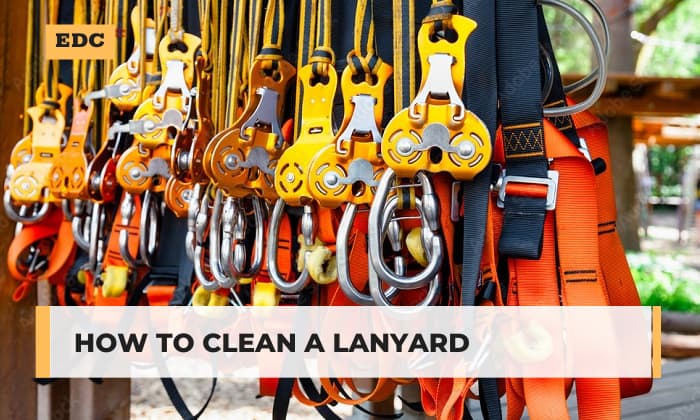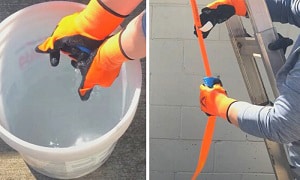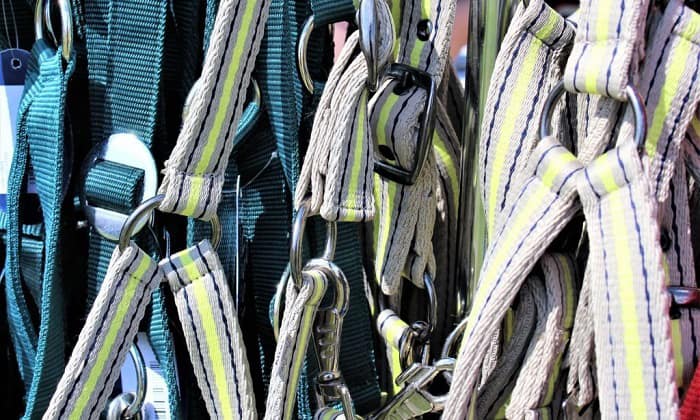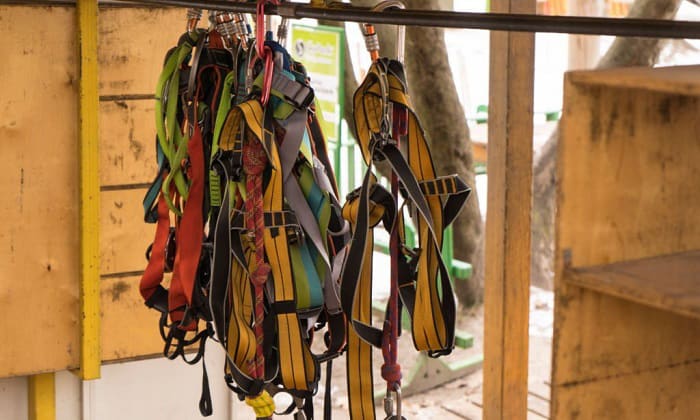Let’s start by defining what a lanyard is. This tool is made of a cord or a webbing, and it comes in various designs. For instance, a Brighton lanyard or a Vera Bradley lanyard is designed to hold objects like knives, identification cards, or keys. Meanwhile, safety lanyards are typically about 3 or 6 feet long and are part of a fall protection system, which is the focus of this article.
As with harnesses, manufacturers require the users to wash their lanyards regularly. Read about the steps on how to clean a lanyard below!
Table of Contents
Ways to Clean a Fall Protection Lanyard with Household Supplies
What to prepare:
- A place or object where you can hang the lanyard (e.g., a ladder or a rack)
- 1 bucket filled with soapy water: Dilute ½ ounce of mild soap or detergent (like Joy and Dawn) with 5 gallons of warm water.
- 1 bucket filled with rinse water
- 2 soft sponges
Step 1: Wash the safety lanyard with soapy water
Hang the safety lanyard on the ladder or hook. Then, load the sponge with soapy water and squeeze out the excess.
Use the sponge to wipe the webbing’s front and back sides and the shock pack. Don’t forget to scrub the metal and plastic components as well.
Step 2: Rinse the lanyard and hang it to dry
Get the other sponge, dampen it with rinse water, and use it to wipe away all the soapy solution on the lanyard.
To dry the equipment, choose a well-ventilated shaded area. Then hang it there until it dries naturally.
Do not put a lanyard in the dryer or use any electronic heating device to dry it.
Ways to Clean Other Lanyards
For ID badges or similar types of lanyards used for work, you may use household and professional cleaning supplies:
1. Clean a leather lanyard with water and alcohol
Combine equal parts cold water with alcohol. Next, use an old toothbrush to apply the solution onto the lanyard and scrub it gently.
2. Wash a fabric or beaded lanyard with diluted mild soap
Pour two parts water and one part mild soap into a spray bottle and give it a good shake. Then, wet the lanyard with this mixture and let it soak for 5 minutes.
3. Use professional cleaning methods
If you want fast and effective results, here are our three recommendations:
- Dry cleaning service
Dry cleaners are mostly available in laundry shops. When handing over your lanyard to the staff, make sure to tell them what kind of stains it contains.
This basic information will help them determine the best way to remove the dirt. Besides that, some types of stains can ruin the webbing during dry cleaning.
- Ultrasonic cleaner
Pop your lanyard into an ultrasonic cleaner if you have one at home and let it do its job—it’s that easy!
However, this can be damaging for lanyards that are made of certain types of glass, gems, or beads. Be sure to read the appliance’s manual before use.
- Steam cleaner
A steam cleaner emits steam to clean. It has multiple hose or nozzle attachments to help you clean various surfaces, furniture, and even clothing!
All you have to do is pour some water into it, push the power button, aim the nozzle at the lanyard, and start cleaning.
Other Tips to Store and Maintain a Lanyard
1. Follow the manufacturer’s cleaning and maintenance instructions
We get a lot of questions from our readers about whether it’s okay to put a lanyard in the washing machine. Well, the answer varies depending on the kind of lanyard and the manufacturer’s recommendations.
Brands like 3M and Honeywell provide specific instructions to clean a fabric lanyard using a washing machine, while others don’t recommend this at all. If you’re unsure, the only way to move forward is to check your lanyard’s user manual.
2. Get a proper storage space for your lanyard
Besides taking the steps to clean lanyards, you should also ensure that they are stored properly. For the most part, safety lanyard manufacturers advise their users to keep the equipment in a space where it is not exposed to sharp and abrasive objects, vibrations, moisture, chemical fumes, and dirt to prevent rapid deterioration.
More importantly, you need to dry the lanyard thoroughly before storing it. Always remember that mildew and molds love to breed in moist environments.
3. Avoid sharing equipment
Generally, providing employees with their own sets of fall protection equipment is a good practice as it ensures that the gear fits them comfortably. However, the recent pandemic also taught us that sharing equipment further spreads the virus.
Importance of Cleaning a Lanyard
1. It prevents the spread of disease
We don’t have to look far for examples. During the recent outbreak, we learned that the COVID-19 virus could transmit when an infected person releases droplets by coughing or exhaling.
Aside from inhaling these droplets, you can get infected by touching your eyes, mouth, and nose after touching surfaces where these droplets land. There is no use in washing our hands if our equipment is ridden with pathogens.
2. It is your best defense against the growth of molds and mildews
It’s not just viruses and bacteria that we need protection from. Practicing proper cleaning and maintenance methods can curb the growth of molds and mildew. These fungi are notoriously known for irritating the wearer’s skin, nose, and eyes. Moreover, it can cause allergic reactions.
3. It prolongs the lanyard’s lifespan
When you wash a lanyard regularly, you can prevent dirt, paints, corrosives, and other harmful substances from accruing on the materials, which can weaken its structural integrity and affect its performance. Beyond that, it can also help prolong the lanyard’s life expectancy.
Conclusion
The instructions we shared on how to clean a lanyard will only take a couple of minutes or an hour to accomplish. After all, it depends on how many pieces of equipment you’re washing and how dirty they are.
Remember that skipping this simple task can result in many consequences, which can range from lanyards infection control risk to damaging the equipment.
On that note, it is crucial to take a few minutes to read the manufacturer’s recommendations for maintenance and storage. This way, you can ensure that your gear functions well when you need it most.
Also read: Detailed Guide on Using Safety Harness and Lanyard

Veronica is our content editor. She is a talent in delivery. Her main work is editing and writing articles that are both informative and simple to follow. She is in charge of synthesizing our understanding of what personal protection equipment (PPE) is needed in each job, how to best apply it, and how to visualize that equipment.









